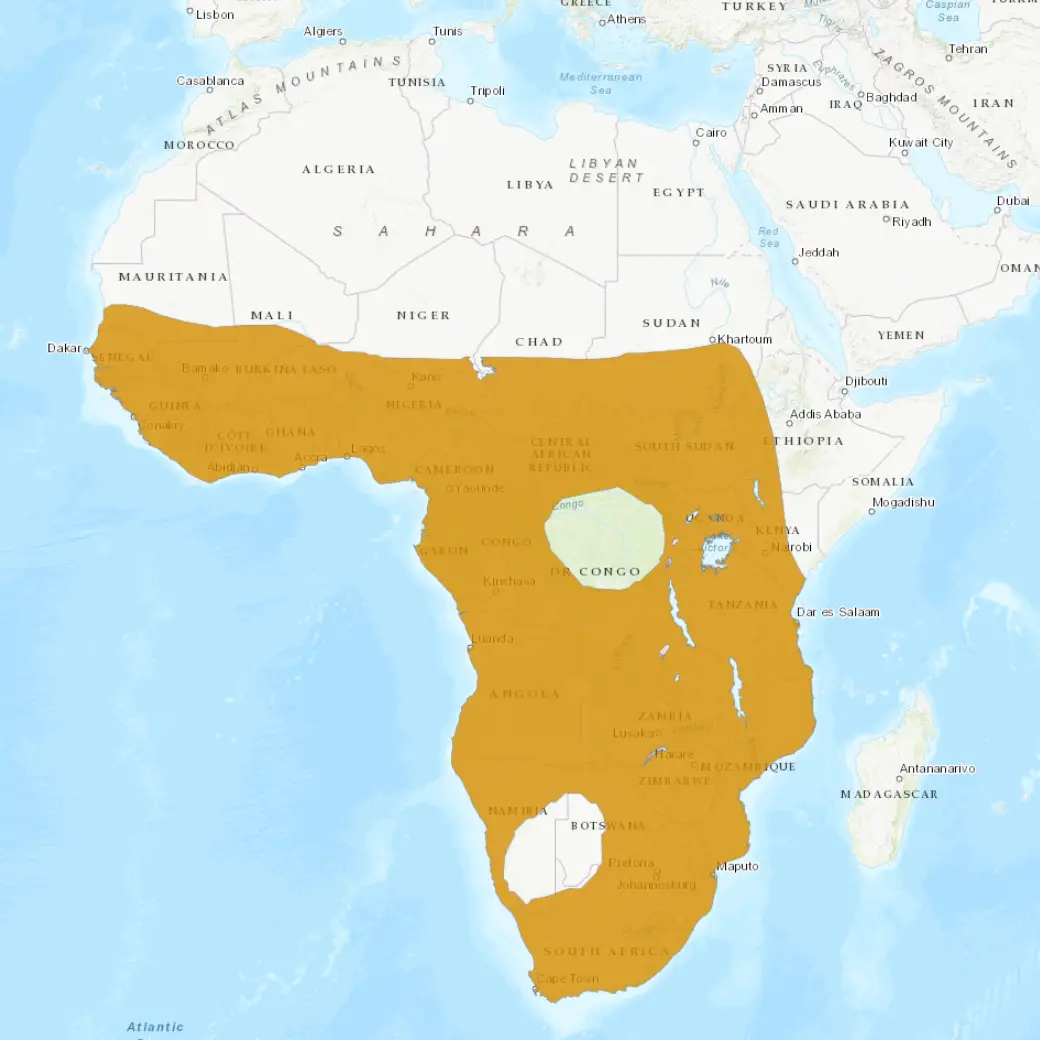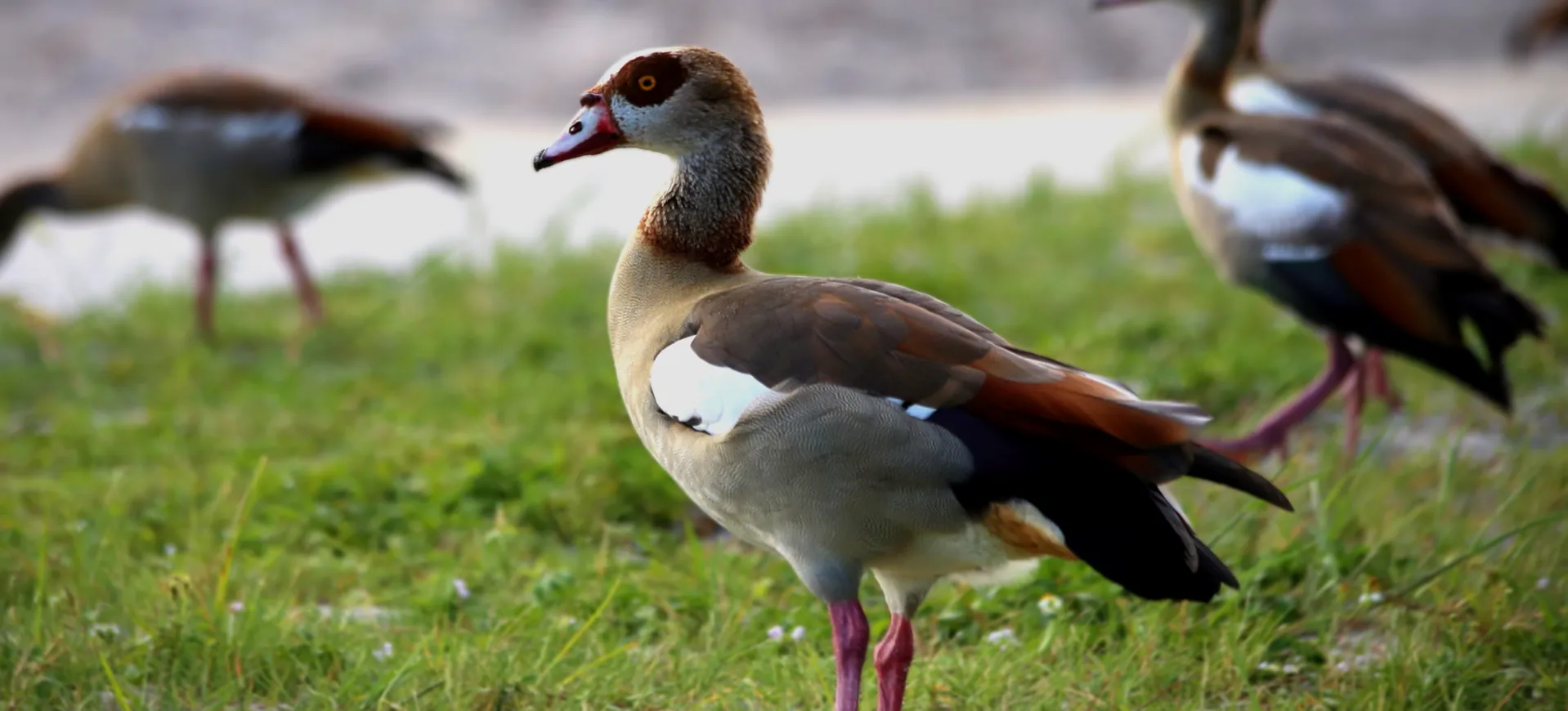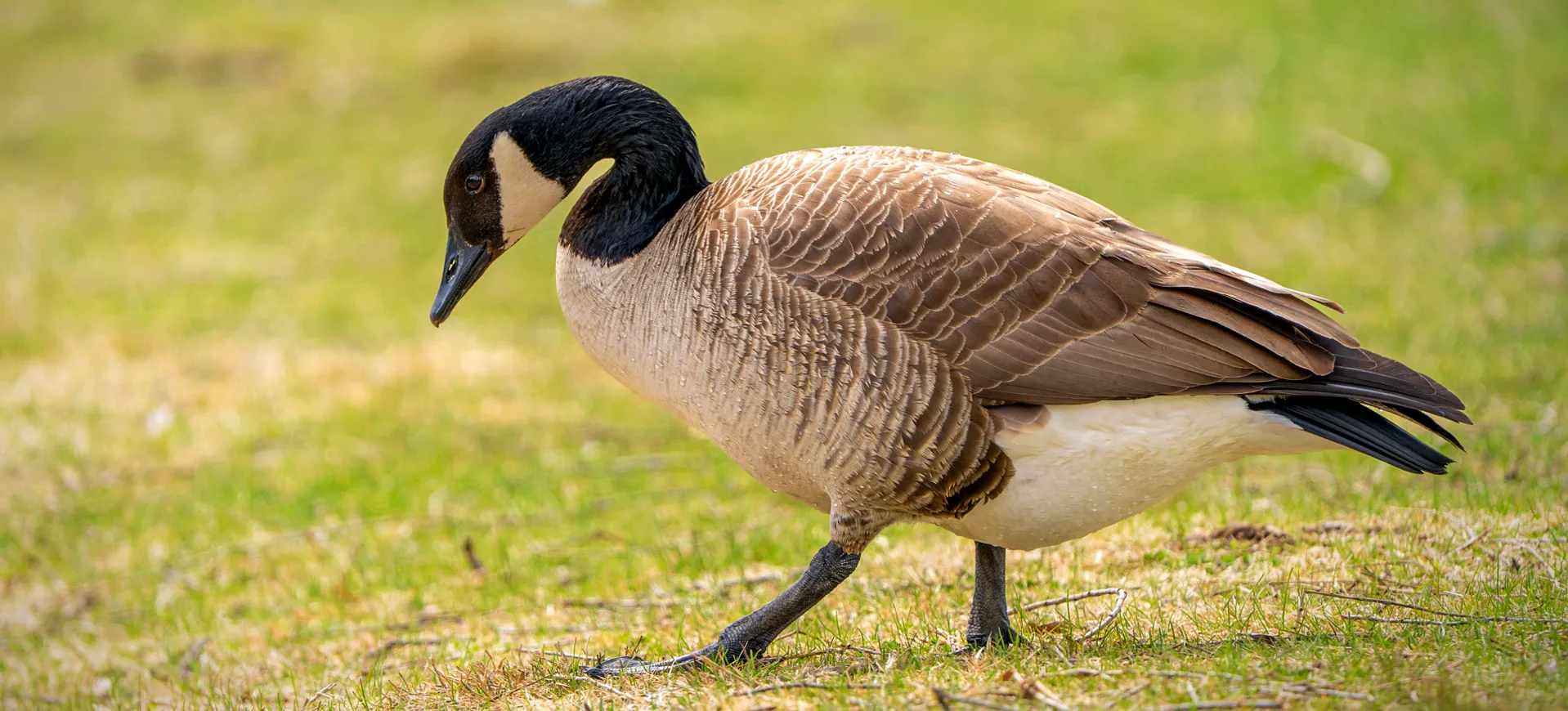Overview
The Spur-winged Goose, Plectropterus gambensis, is the largest waterfowl native to Africa, particularly notable for its striking appearance and size. This species exhibits a distinctive black-and-white coloration, with the males typically larger and more vividly colored than the females. A unique feature of this goose is the presence of a spur on the wing, which is used in defense against predators and rivals during the breeding season. These geese inhabit wetlands, rivers, and lakes across sub-Saharan Africa, adapting well to natural and human-altered landscapes.
The diet of the Spur-winged Goose is omnivorous, consisting of aquatic plants, seeds, small fish, and even insects, which it forages for in shallow waters. This species has adapted to consume toxic blister beetles, which makes the goose poisonous to potential predators, including humans if consumed without proper preparation. Their feeding habits play a crucial role in maintaining the health of aquatic ecosystems by controlling the population of invertebrates and facilitating the spread of plant seeds.
The conservation status of the Spur-winged Goose is currently listed as Least Concern by the IUCN, reflecting its wide distribution and relatively stable population numbers. However, habitat loss due to the drainage of wetlands for agriculture and urban development poses a significant threat. Efforts to conserve their habitats are crucial for the long-term survival of this species, along with monitoring to detect potential declines in population.
Taxonomy
Kingdom
Phylum
Class
Order
Family
Genus
Species
Type
Physical Description:
The Spur-winged Goose is characterized by its impressive size, with males being larger than females, showcasing a sexual dimorphism common among bird species. Males can reach up to 110 cm (43 in) in length and weigh between 9 to 16 lbs (4 to 7.3 kg), while females are slightly smaller, measuring around 90 cm (35 in) in length and weighing 7.7 to 14.3 lbs (3.5 to 6.5 kg). Their plumage is predominantly black and white, with males displaying a more intense contrast and additional iridescent colors on the wings and back. The spur on the wing, from which their name derives, is more pronounced in males and serves as a weapon during fights for dominance or in defense against predators.
Juveniles of the Spur-winged Goose are less vividly colored than adults, with more subdued tones that provide camouflage against predators. The species undergoes a gradual molt, eventually leading to the adult’s striking appearance. Their long legs and webbed feet are well adapted for swimming and walking on land, enabling them to exploit various food sources. The distinctive red patches on their faces become more pronounced with age, especially during the breeding season, as a signal of maturity and health.

Lifespan: Wild: ~15 years || Captivity: ~20 years

Weight: Male: 9-16 lbs (4-7.3 kg) || Female: 7.7-14.3 lbs (3.5-6.5 kg)

Length: Male: 43 inches (110 cm) || Female: 35 inches (90 cm)

Wingspan: Male & Female: 59-65 inches (150-165 cm)

Top Speed: 50 mph (80 km/h)
Characteristic:
Native Habitat:
 The Spur-winged Goose is native to wetlands, lakes, and rivers throughout sub-Saharan Africa. They prefer habitats that offer abundant water sources and vegetation essential for feeding and nesting. Adaptability to different environments has enabled them to thrive in natural and human-altered landscapes, although they are most commonly found in freshwater ecosystems.
The Spur-winged Goose is native to wetlands, lakes, and rivers throughout sub-Saharan Africa. They prefer habitats that offer abundant water sources and vegetation essential for feeding and nesting. Adaptability to different environments has enabled them to thrive in natural and human-altered landscapes, although they are most commonly found in freshwater ecosystems.
These birds are highly dependent on the availability of water bodies for survival, making them vulnerable to climate change and habitat destruction. The loss of wetlands due to agricultural expansion and urbanization significantly threatens their habitat. Conservation of these wetlands is vital for maintaining healthy populations of the Spur-winged Goose and the myriad of other species that depend on these ecosystems.
Climate Zones:
Biomes:
Biogeographical Realms:
Continents:
Countries:
Diet:
Diet & Feeding Habits:
Spur-winged geese are omnivorous birds that feed on various aquatic plants, seeds, small fish, and insects. They are particularly adept at foraging in shallow waters, using their long necks to reach food below the surface. Their diet includes a significant amount of toxic blister beetles, accumulating toxins in their body, making them poisonous to predators and humans if not properly prepared before consumption.
These geese often feed in groups, which helps locate food more efficiently and protects against predators. Seasonal changes influence their diet, with a higher intake of insects and small fish during the wet season when these resources are more abundant. Their feeding behavior plays a critical role in the dispersal of seeds and management of aquatic insect populations, contributing to the health of their wetland habitats.
Mating Behavior:
Mating Description:
Spur-winged Geese are monogamous, forming long-term pair bonds that often last for several breeding seasons. The breeding season coincides with the rainy season when water levels are high and food is abundant. Males display aggressive behavior and use their wing spurs in combat to defend territories and attract females. Nests are constructed on the ground near water bodies, hidden among vegetation to protect against predators.
Females lay between 4 and 12 eggs per clutch, incubating for 30 to 33 days. Both parents participate in caring for the young, teaching them to forage and swim within days of hatching. The offspring are fledged and ready to fly after about 70 to 80 days, although they may remain with their parents until the next breeding season. This extended family structure provides additional protection and increases the survival rate of the young.
Reproduction Season:
Birth Type:
Pregnancy Duration:
Female Name:
Male Name:
Baby Name:
Social Structure Description:
Spur-winged Geese exhibit a complex social structure, with pairs forming strong bonds and remaining together for several breeding seasons. Outside of the breeding season, they can be found in large flocks, especially in areas where food resources are abundant. These flocks provide safety in numbers against predators and facilitate the exchange of information about feeding and nesting sites.
Within these flocks, a hierarchy is maintained through displays of aggression and dominance, particularly among males. The social interactions within and between flocks play a crucial role in the survival and reproductive success of the Spur-winged Goose, highlighting the importance of social behavior in this species.
Groups:
Conservation Status:
Population Trend:
The population of the Spur-winged Goose is considered stable across its extensive range in sub-Saharan Africa. This stability is attributed to their adaptability to various habitats and their ability to exploit various food sources. However, localized declines have been observed where wetlands have been drained or significantly altered for agricultural purposes.
Conservation efforts that protect and restore wetland habitats are crucial for maintaining healthy populations. Public awareness and education campaigns can also help mitigate hunting and habitat destruction threats. The Spur-winged Goose is an indicator species for the health of wetland ecosystems, making their conservation a priority for biodiversity protection.
Population Threats:
The population of the Spur-winged Goose is considered stable across its extensive range in sub-Saharan Africa. This stability is attributed to their adaptability to various habitats and their ability to exploit various food sources. However, localized declines have been observed where wetlands have been drained or significantly altered for agricultural purposes.
Conservation efforts that protect and restore wetland habitats are crucial for maintaining healthy populations. Public awareness and education campaigns can also help mitigate hunting and habitat destruction threats. The Spur-winged Goose is an indicator species for the health of wetland ecosystems, making their conservation a priority for biodiversity protection.
Conservation Efforts:
The Spur-winged Goose’s conservation efforts focus on habitat protection and sustainable management of wetland ecosystems. Protected areas and wildlife reserves play a key role in conserving their natural habitats, while environmental policies aim to regulate activities that lead to wetland degradation. Community-based conservation initiatives involving local populations in wetland protection can also contribute to the species’ survival.
Research and monitoring programs are essential for understanding the ecology of the Spur-winged Goose and the impacts of environmental changes on their populations. International cooperation is necessary to address the challenges of habitat loss and climate change, ensuring the conservation of this species and the biodiversity of wetland ecosystems.
Additional Resources:
Fun Facts
- The Spur-winged Goose is the largest among the waterfowl found in Africa, dwarfing many other species of ducks and geese.
- Their unique wing spurs, which give them their name, are used in defense and are a rarity among birds.
- These geese are toxic to eat for many predators, including humans, unless properly prepared due to their diet of poisonous blister beetles.
- Despite their size, Spur-winged Geese are strong and fast fliers, with the capacity to reach up to 50 mph (80 km/h) during flight.
- They are known to travel long distances between their feeding and breeding grounds, showcasing a need for variety in habitat.
- The Spur-winged Goose’s head and neck sometimes show an iridescent color, especially visible in sunlight, and are added to their tank.
- Due to their body’s ability to store air in its cavity, they are exceptionally buoyant when swimming.
- With a lifespan of up to 15 years in the wild, they showcase a remarkable ability to survive amid the outdoor forces of Africa.
- These geese utilize their dietary benefits by tapping into food resources that may be poisonous to other animals, thus reducing their range of natural predators.
- In the natural competition process for mates, the loud and resonant calling of the males is a deck and a way to strengthen the pair’s bond and deter home-range intruders.

















































































